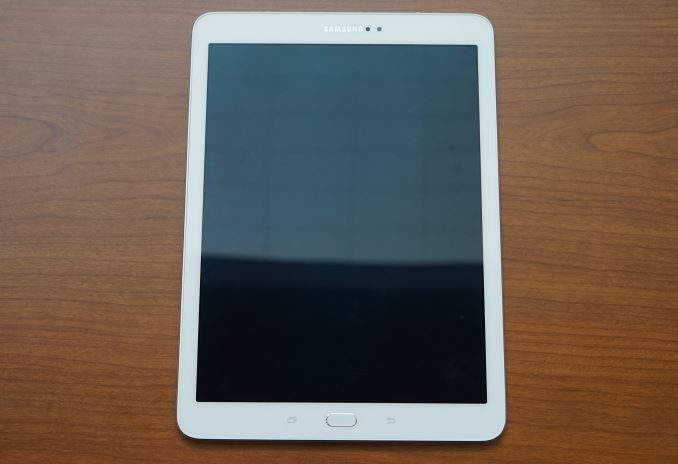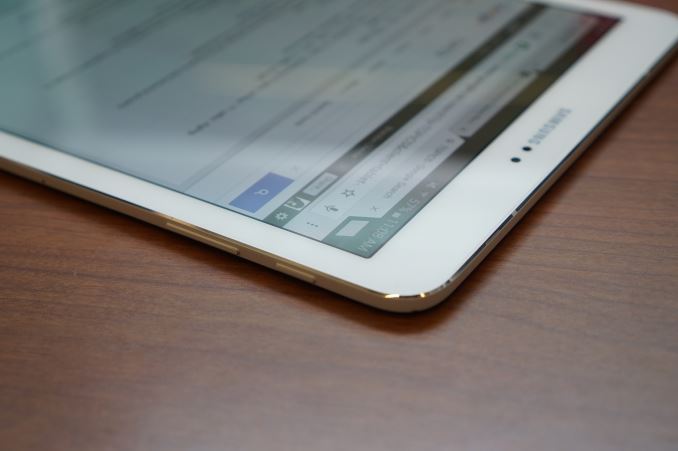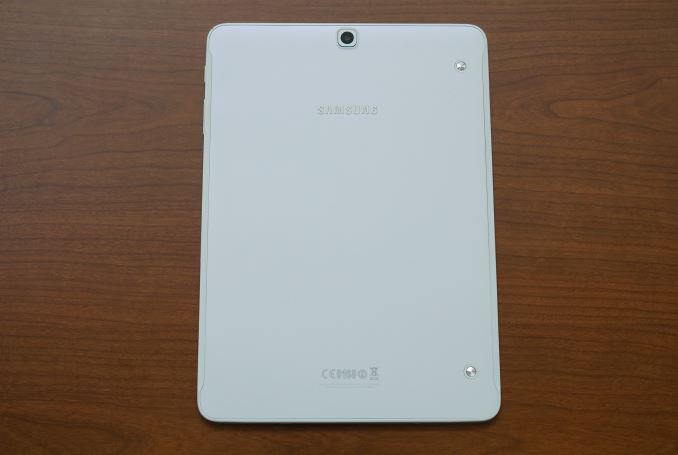The Samsung Galaxy Tab S2 Review
by Brandon Chester on October 15, 2015 8:00 AM EST
The first Android tablet I ever used was the original Galaxy Tab. It was a 7" Android tablet running Android Froyo, and it seemed a lot like a large version of my Galaxy S. In hindsight, it wasn't a very good tablet, but Samsung was one of the first Android vendors to enter the market and they were working with a version of Android that had never been designed with tablets in mind. As Android moved to Gingerbread and then to the tablet exclusive release of Android Honeycomb, Samsung was always among the group of manufacturers producing Android tablets. While some vendors like LG and HTC have left and returned to the tablet market, Samsung has continually producing new Galaxy Tab tablets, and those tablets constitute a very large portion of the Android tablets that are sold each year.
While the naming styles of Samsung's tablets have changed over the years, last year the company settled on using the same S moniker that their smartphones have used for years, and that brought us the Galaxy Tab S 10.5 and Galaxy Tab S 8.4. This year Samsung has continued with their Galaxy Tab S naming scheme and has released two new tablets under the Galaxy Tab S2 name. These new tablets bring serious changes to both the hardware and form factors of the original Galaxy Tab S tablets, and I'll be evaluating the larger of the two models. You can view the specs for both tablets and how they compare to their predecessors in the chart below.
| Samsung Galaxy Tab S Series | ||||
| Model | Samsung Galaxy Tab S 10.5" | Samsung Galaxy Tab S 8.4" | Samsung Galaxy Tab S2 9.7" | Samsung Galaxy Tab S2 8.0" |
| SoC | Samsung Exynos 5420 4x Cortex A15 @ 1.9GHz 4x Cortex A7 @ 1.3GHz Mali T628MP6 @ 533MHz |
Samsung Exynos 5433 4x Cortex A57 @ 1.9GHz 4x Cortex A53 @ 1.3GHz Mali T760MP6 @ 700MHz |
||
| RAM | 3GB LPDDR3 | |||
| NAND | 16/32GB NAND + microSDXC | 32/64GB NAND + microSDXC | ||
| Display | 10.5" 2560x1600 SAMOLED | 8.4" 2560x1600 SAMOLED | 9.7" 2048x1536 SAMOLED | 8.0" 2048x1536 SAMOLED |
| Dimensions | 247.3 x 177.3 x 6.6mm | 212.8 x 125.6 x 6.6mm | 169 x 237.3 x 5.6mm, 389g | 134.8 x 198.6 x 5.6mm, 265g |
| Camera | 8MP Rear Facing. 2.1MP Front Facing | |||
| Battery | 7900mAh (30Wh) |
4900mAh (18.6Wh) |
5870mAh (22.3Wh) | 4000mAh (15.2Wh) |
| OS | Android 4.4.2 KitKat | Android 5.0 Lollipop | ||
| Connectivity | 2x2 802.11a/b/g/n/ac + BT 4, GNSS, microUSB 2.0 | |||
| Launch Price | $499 | $399 | $499 | $399 |
As far as specs go, we're looking at some serious upgrades, and some changes that may be seen as sidegrades or even downgrades. First and foremost, the SoC receives an enormous bump from Exynos 5420 to Exynos 5433. Unfortunately, like the Galaxy Note 4 Exynos, the Galaxy Tab S2 still has a 32bit kernel and runs in AArch32 mode. Fortunately this doesn't really have any significant performance implications, but I thought it was worth noting for anyone that may be interested.
Moving beyond the SoC, you may notice that the resolutions and sizes of the displays change substantially. Samsung, like many other vendors, is finally moving away from the 16:10 aspect ratio and adopting a 4:3 display ratio which is very close to the 8.5x11" paper used in North America, although not as close to the A series paper used in most other countries. Samsung has settled on 8.0" and 9.7", the latter of which surprises me as it's the exact same size as the standard iPad despite Samsung being able to make displays of whatever size they wish.
What's interesting is that in moving to a new aspect ratio and smaller sizes, both displays lose almost a million pixels of resolution. The drop in PPI on the larger model is fairly significant too, from 288ppi on the Tab S 10.5" to 264ppi on the Tab S2 9.7" In practice I really don't think this matters that much on the 9.7" Tab S2, as I never felt like any elements of the UI or text looked heavily aliased or fuzzy. That being said, with Samsung making their own OLED displays it would have been perfectly possible to maintain their existing pixel density and just make panels of different sizes.
With the new display sizes come new form factors, and both tablets are substantially thinner and lighter than their predecessors. This also results in a drop in battery capacity as there's only so much room to fit batteries inside the chassis, and how this impacts battery life will be investigated later in the review.
Design
When Samsung announced the Galaxy S6 and S6 Edge I uttered a well-deserved "finally" with regards to the design of the phones. The aluminum and glass construction was a long overdue and greatly appreciated improvement to Samsung's existing industrial design, and I still think the Galaxy S6 is a pretty great looking and feeling device. However, upon seeing that the design really only used a metal frame and a sheet of glass overtop of a plastic back, I immediately knew that there was no way the design would scale up to tablets. There's simply too much fragility in that type of design, especially as you scale it larger. Since I suspected that Samsung still wasn't at the point where they would be producing aluminum unibody tablets, I wasn't surprised by the design of the Tab S2 tablets when they were announced.
Both versions of the Tab S2 have the same thickness, just 5.6mm. The larger model of the two that I am reviewing has a mass of 389 grams. The thickness and mass are enabled by the Tab S2's construction, which consists of a metal frame around the edges of the device but a plastic back cover. This is obviously a trade off, and I'll start with what's good before discussing what negatives come from it. The most obvious advantage is the low mass. When you pick up the Tab S2 you will be amazed that you're holding a full size tablet. You can't really notice a difference between its 5.6mm thickness and the 6.1mm thickness of the iPad Air 2, but the difference made by the lower mass is enormous. This is the first full size tablet I've used where I can honestly say I don't feel fatigued after holding it for a long period, and that's something you can't really accomplish with an aluminum unibody chassis. In that regard, the Tab S2 definitely has an advantage over every other full size tablet that I've used, and it encourages you to use it more and take it with you in situations where you may decide to leave a heavier tablet at home.
Of course, the obvious negative impact is the feel of the device. The metal frame honestly does nothing to improve the feeling of the Tab S2, especially on this white model which has a coating applied to the frame. The coating also doesn't seem very durable, and there were already chips in it by the time the tablet got to me. Overall it just doesn't feel as nice or well-built when you hold it as an aluminum unibody tablet does. What also disappointed me is that even though it's 5.6mm thick, there's still a small degree of flex to the back cover, particularly near the bottom. The materials used in a tablet can also have an impact on thermal performance which could limit performance in sustained workloads.
Making a device ends up really being a balance of trade offs. I love how light the Tab S2 is, but I'm not a huge fan of the materials used. Every consumer will have their own priorities, and I'm sure many people will find that the low mass and small thickness is worth the compromise in materials. It's also worth noting that this year's design is still miles ahead of the terrible dimples and faux leather plastic of the original Tab S, even if it's not at the level of the Venue 8 7840 or the iPad.
While I'm still on the topic of the materials and the back cover, you'll notice above that the back cover has two metal circles on the back. These are used for attaching Samsung's keyboard cover. I actually wasn't able to get the keyboard cover and I haven't seen it on sale anywhere at this point, but the existence of a first party keyboard case is something worth noting. As for the rest of the back cover, it's pretty much just an unbroken piece of plastic apart from the slightly extruding camera stack and the Samsung logo in the middle.
As far as primarily plastic tablets go, the Tab S2 is a pretty good device. I love how light it is, but at the same time I don't feel like the plastic build befits a $500 flagship tablet. It also doesn't feel quite as sturdy as the Venue 10, but I think Samsung's goal was to make a thin and light device that wouldn't be cumbersome to hold and carry around. They definitely succeeded in doing so, and I think that while there's a group of users like myself that feel a $500 device deserves the absolute best construction and materials, there's another group that feels the $500 should go toward making a device as light and portable as possible.













162 Comments
View All Comments
WorldWithoutMadness - Thursday, October 15, 2015 - link
Pardon, is it typo on intro and design table, 'Samsung Galaxy Tab S2 8.4" ', is it really S2 or Samsung went wonky with this tablet line?Ryan Smith - Thursday, October 15, 2015 - link
That was indeed a typo. Thanks!donnieevans - Saturday, November 14, 2015 - link
I have a Samsung Galaxy Note Pro and this is the best table I've ever had! It's 32GB, can open multiple apps at the same time. The display is also amazing! Found at: http://www.consumerrunner.com/top-10-best-tablets/GodHatesFAQs - Thursday, October 15, 2015 - link
I bought a Tab S 8.0 earlier in the month, but had to return it over PenTile pixel arrangement which caused everything to look fuzzy and was not sharp at all. Display just didn't have the wow factor of last year's model. I think around 400ppi on RGB or 600ppi on RGBG PenTile is the real limit (at least for my eyes) for a display to be really sharp.I really hope Apple moves to 3072x2034 (3x rather than 2x) with iPad Air 3 with locally dimmed backlight like the iPhone 6s/Plus. It won't be as deep black as AMOLED displays, but I'm not willing to sacrifice sharpness for deep blacks.
Solandri - Thursday, October 15, 2015 - link
The whole point of pentile RGBG is that you don't need 600 ppi RGBG to equal 400 ppi RGB. The green resolution for that pentile display would be 600 ppi, while the red and blue would be 300 ppi.Your eyes are sharpest in green, with blue being really bad, and red only slightly better. Pentile attempts to match that (or put another way, RGB has way more R and B subpixels than it needs. Just look at the images on this site where the R, G, and B channels have been reduced to 1/3 and 1/4 their original resolution. The image with the reduced blue channel is nearly indistinguishable from the original. The one with the reduced red channel is barely distinguishable. While the one with the reduced green channel is absolutely terrible.
http://nfggames.com/games/ntsc/visual.shtm
In other words, if the individual pixels are smaller than the resolving limit of your eye (about 0.5 arc-minutes), then 400 ppi RGB can be replicated with 400 ppi RGBG pentile. If you don't believe me, consider that every color video format uses this trick to reduce bandwidth by reducing blue and usually red resolution. You've already been looking at the equivalent of pentile images on TV your entire life.
krumme - Thursday, October 15, 2015 - link
Thanx.Look at samsung galaxy s2 rgb next to a s3 pentile and its pretty obvious the s3 is far far sharper subjectively.
As for the tab s2 beeing unsharp its damn nonsense to me and i regard myself as very sensitive and prefer higher than 1080p on a 5 display. I dont know how close the person above uses the tab s2 but for my part its very much like my note 3 and it means the tab s2 looks sharper to me.
Now the s2 is damn light. Only a bit more than a s6plus lol so you use it more like a smartphone but never is it closer than 40cm for my usage. Its a 8 inch.
Wwhat - Tuesday, October 20, 2015 - link
NTSC was a very bad example of a color format, and you switched cause and consequence around, they had too little bandwidth, so they used desperate tricks to cram color into it, that's not an ideal situation.The same thing is still done but now to save cost and chip/PCB bandwidth, but that doesn't mean it's equal to the real thing.
Plus they go for the average person, which means that there can be a large number of people for whom it DOES make a difference.
Hell, when they introduced MP3 they also said that 128Kbit (and joint stereo) was the same as CD quality 'basically' (sometimes they even claimed the same for half that bitrate). But such things are based on theoretical papers and on the average person and on 'good enough for now' thinking, and don't represent a perfect world.
The difference between a person with very sharp eyesight and the average person can be astounding, some people have twice or even four times better eyesight than average. There are notable incidents in that with famous astronomers and jet fighter pilots demonstrating the difference in a pronounced manner. And it's a pure coincidence if you are such a person, but they do exist. But at the same time there are many people who truly could not tell the difference of course, but there is no reason to start denying each other's existence. Nor is there a reason to feel superior/inferior since we all have strengths and weaknesses in various areas.
thedons1983 - Saturday, October 17, 2015 - link
I'm sorry, but there is something wrong with your eyes... The one thing that these tablets have going for them, is the incredible screen. If you can't appreciate the quality of it, then there is something wrong with your sight.theduckofdeath - Sunday, October 18, 2015 - link
Full time Apple trolls on the internet?! What a shocker!lurker22 - Thursday, October 15, 2015 - link
Issue with android tablets, will they get software updates in a year or two